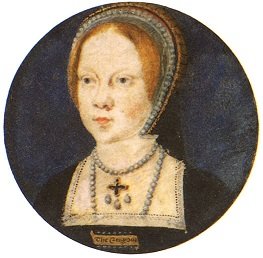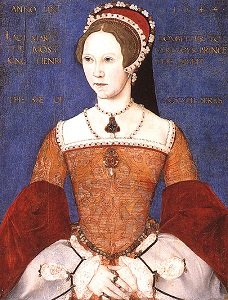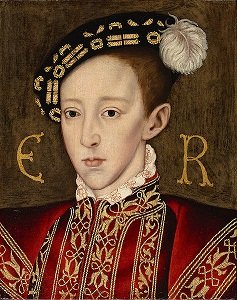Mary Tudor, the Bloody Queen
England has had many monarchs – some lionized and almost deified, some derided as weak, or bad, or mad. Arguments over these kings rage still today – the verdict on Richard III, for example, has yet to be settled. But few have raised such ire as the first undisputed Queen of England in her own right, Mary Tudor. Denounced by her subjects after her death as a bloody tyrant, was she truly as bad as she was painted?
It’s not exactly the case that Mary was an unwanted child. Both of her parents seem to have loved her deeply, though she was not the son they had prayed for. She was born in 1515 as the fourth child of the marriage between Henry VIII and Katherine of Aragon, but none of her brothers had managed to survive more than a few weeks. It’s easy to forget how, even for the rich, so few children made it through infancy. All three of her brothers had been named Henry, after their father, and perhaps she would have been too if she were male. Her survival did seem to show that the marriage could still produce an heir, but after Katherine had another daughter (who also didn’t survive infancy), even though she was only 33 she seemed incapable of any more pregnancies. Life was rough in the 16th century.

This left Henry in a dilemma. He had become heir to the throne after his brother Arthur’s death left him the only son of Henry VII, who had also been an only son. The wars of the previous two generations (known as the Wars of the Roses) had thinned out the royal lines, and Henry VII had thinned them out further to ensure the stability of the Tudor line. What that meant, however, was that Henry VIII was left with no legitimate male heir. He had only three real options. One was Henry Fitzroy, an illegitimate son from one of his many mistresses. He was healthy, intelligent and could make for a good king, if legitimised. His reign would always be in doubt, however, and he would face many rebellions. Another was Mary. Though no female monarch had ever ruled England [1] it was not unknown on the continent for women to take the throne. In order to leave this option open, Mary was given her own court and some of the rights and responsibilities due to an heir. Though she was never officially confirmed in the title, she was addressed by her servants as “Princess of Wales”.
The third option, and the one Henry eventually determined on, was to end his marriage with Katherine and take a new wife. This was not a simple affair. There was no divorce within the Catholic faith, and Henry was a loyal son of the church. What was available was annulment, the acknowledgement that a marriage was never legal to begin with. Henry sought to annul his marriage with Katherine on the grounds that she was his brother’s widow, and so their marriage constituted incest. There were a few issues with that. The first was that Henry had sought and received a papal decree that this was not the case before he married her. The second was that the Pope was at the time within the power of the Holy Roman Emperor, Charles V. He was Katherine’s nephew, and was not going to permit the Pope to agree to annul her marriage. And Katherine herself, of course, opposed the annulment to the greatest of her ability. She had no wish to have her daughter declared illegitimate. The end result was that the marriage would not be annulled by the Pope, and so Henry had to take drastic action.
What Henry did was renounce the ability of the Pope to pronounce judgement on affairs in England. He did not break with the Church, he simply no longer acknowledged its authority. Instead he himself declared the marriage annulled in 1533, and remarried to Anne Boleyn. [2] At a stroke the seventeen year old Mary was declared illegitimate and disinherited. Her household was been given over to her new half-sister, Elizabeth, who Mary immediately (and understandably hated). She refused to grant Elizabeth recognition as a princess, and never accepted her father’s remarriage. Mary was forbidden to see her mother, who had been exiled from the court. When Katherine died in 1536 Mary had not seen her in years. She was heartbroken.

1536 did bring some good news for Mary though – the fall from grace and execution of the woman who had replaced her mother. The exact reason for Anne’s downfall is hard to pin down – the simplistic view is that she had “failed to produce a son”, but she was only 35 years old and had only been married to the King for three years. More likely is political manoeuvring – Anne was the figurehead of one main faction in Henry’s court, and her fall was probably organised by the leader of the other faction, Thomas Cromwell. The actual charges used to justify her execution – adultery, incest and witchcraft – were definitely false, of course. She was immediately replaced by a wife firmly in Cromwell’s camp, Jane Seymour. Mary got along far better with Jane, and the two became friends. (Elizabeth, as the daughter of a traitor, was now firmly out of favour.) Jane actually pushed for Mary to be restored to the line of succession (behind any of her children) and though she didn’t succeed, she did reconcile Mary with her father. The following year, in 1537, Jane gave Henry the male heir he had been waiting for. However, in a sadly common turn of events at the time, his birth led to her death. Mary led the procession of mourners at the funeral.
Over the next few years several marriages were considered for Mary, but none came to pass. Though she remained privately Catholic, she agreed to acknowledge her father’s authority over “the church in England”, even after her godmother was executed for taking part in a Catholic plot. Mary herself was the centre of several plots, but she wisely remained uninvolved and so untainted. Through the remainder of Henry’s reign, she was a staple at court and served as host during the gaps between his remaining marriages. In 1544 he finally agreed to restore her and Elizabeth to the succession (behind Edward, his son with Jane). Finally, in 1547, he died.

At her father’s death Mary inherited enough estates to give her independence, or so it would seem. In truth, like all those in England she survived at the king’s mercy. And the king was only nine years old. The true power lay with his council of regents, led by his uncle Edward Seymour. Seymour’s rule was precarious, though – he was forced to have his younger brother executed, for example, when he caught him trying to marry Elizabeth. In 1549 he was removed from power and executed by John Dudley, the earl of Warwick. Dudley’s accession didn’t change one thing though – the aggressive Protestantisation of England. Henry had broken with Rome, but had remained largely faithful to Catholic doctrine. Edward’s regents now used their power to skew further and further away, creating their own prayer books and rites. In 1549 a law was passed declaring the use of these for church services mandatory, though Mary (thanks to political pressure from her cousin, the Holy Roman Emperor) was able to keep practising her Catholic mass. Still, on one occasion when she attended in Christmas 1550 the 13 year old Edward publicly rebuked her for her faith. As a result she withdrew into seclusion – with almost fatal consequences.
In 1553, at the age of sixteen, Edward contracted tuberculosis. His advisers knew that his days were numbered, and had him exclude his two sisters from the succession in his will – ostensibly to prevent the Catholic Mary from gaining the throne. Conveniently, though, this would leave his cousin Jane – who was married to the son of his chief adviser, John Dudley – as heir to the throne. With that settled, Edward died (conveniently) on the 6th July. Shortly prior to this Mary had been summoned to court to visit her sick brother, but she saw the trap and fled into East Anglia where she rallied her supporters. Dudley had Jane proclaimed Queen and then rode out with an army to meet Mary, but as soon as he left London the Privy Council gauged the mood of the public and decided to switch their allegiance to Mary. Jane and her husband were imprisoned on the 19th July, after nine days as Queen Apparent. Between that and his discovery of the unexpectedly large size of Mary’s army, Dudley decided to surrender. The day before Mary’s representatives arrived to arrest him, he is said to have declared her Queen in the market place, and then laughed until he cried.

Mary entered London in triumph, the public apparently far less discomfited by the idea of a female monarch than her father had expected. Dudley, of course, she had executed but the rest of his conspiracy she granted mercy. Even Lady Jane was spared, though she was declared guilty of treason and kept imprisoned. Mary carried out the suspended sentence of death on her the following year, after a Protestant revolt broke out against her marriage to the Spanish heir, Prince Philip. The same revolt almost led to Elizabeth’s execution, but she was able to convince Mary of her innocence. She was one of the lucky ones. Though Mary had initially declared she would respect religious freedom, it soon became apparent that she, a devout Catholic, regarded the religious practises her father and brother had supported, as heresy. Throughout 1554 she was negotiating the terms of the return of England to the Catholic church, and by the end of the year the deal was struck. She got to keep the lands and property taken from the church by her father, and in return she revived the Heresy Acts. The practise of any religion other than Catholicism became punishable by death. Around 300 people were fed to the flames, including the Archbishop of Canterbury, Thomas Cranmer.
The persecutions were not the main reason for Mary’s drop in popularity, though. As always, the monarch was the land, in the eyes of the people. When the land suffered, it was the unrighteousness of the ruler to blame, and in those years the land suffered. Flooding led to famine, while the alliance with Spain cut off an important revenue stream – preying on their transports of goods from South America and the West Indies. It had been hoped the alliance would allow England to take advantage of those discoveries, but Spain guarded them jealously. So the land suffered, and with it the people’s opinion opinion of their Queen.

Another reason Mary had allowed Elizabeth to survive was that she was, as Mary was forced to recognise, the only viable Tudor heir. Mary was 37 when she became Queen, and due to her brother’s antipathy and her own resistance to the Protestant candidates he had proposed, still unmarried. As such the matter of succession became even more of a concern than it had been for her father. Mary’s marriage to Philip was hardly a close one – he spent most of his time in Spain, she in London – and it had a single goal, to produce an heir to both their kingdoms. Towards the end of 1554 Mary became pregnant, and in early 1555 she had Parliament pass a law preemptively declaring Philip regent if she had a child but died in childbirth. A grim prospect to face. Along the same lines she had Elizabeth brought to court, ostensibly to attend the birth but clearly to prevent her becoming a focus of rebellion. There were rumours that Philip planned to force her to marry him, if Mary died. However as the expected delivery date passed, it soon became clear that despite her symptoms Mary was not actually pregnant. She regarded the false pregnancy as a punishment for tolerating heresy and it fuelled the persecution of recalcitrant Protestants. However she also kept Elizabeth in court, as heir apparent. In 1557 Mary once again thought she had become pregnant, but it seems that what she really had was some form of abdominal cancer. She died in May of 1558, having reigned as queen for just under five years.
Mary’s successor Elizabeth avoided many of the mistakes her sister had made. Though she rejected the Catholic faith (under which she had no right to inherit the throne) she also avoided the proselytising Protestantism of her brother. Instead she sought to fuse the two traditions and create something palatable to both camps. This naturally led her to have much less need to resort to heresy trials than Mary, and made her immediately more popular. The early seeds of Mary’s bloody portrayal in history began here, as her reputation suffered when held against her successor. Mary had been especially hated by John Knox, the founder of Scottish Presbyterianism. As such, when Elizabeth was succeeded by James I she became an immediate example of the tyrannical nature of Catholic rule. The narrative of “Bloody Mary” was soon established, and remained largely unchallenged until relatively recent times. This is not to say that Mary didn’t have a large number of people killed. The death toll for heresy charges during her reign (60 a year) is much higher than that of the infamous Spanish Inquisition, for example (around 3,000 over 240 years). Yet during the reign of George III, hardly remembered as a tyrant, twenty times as many would be executed for often the smallest of crimes. Mary was hardly (despite some views to the contrary) a saint. But she was not that much more terrible than many rulers, and a great deal better than some.
Images via wikimedia and Tudor History.
[1] The one previous female heir, Matilda, had tried to claim the throne on her father’s death. The resulting opposition had led to a generation of civil war known as The Anarchy.
[2] It’s a common fallacy that it was desire for Anne that motivated Henry to seek his annulment. While he probably chose her as his new wife based at least partially on being attracted to her, she also had strong family connections to English nobles whose loyalty he would confirm with this. Besides, if Henry had desired her, he could easily have made her his lover – another attraction of Anne was that her elder sister Mary, one of Henry’s mistresses, had already born him a healthy male child.
